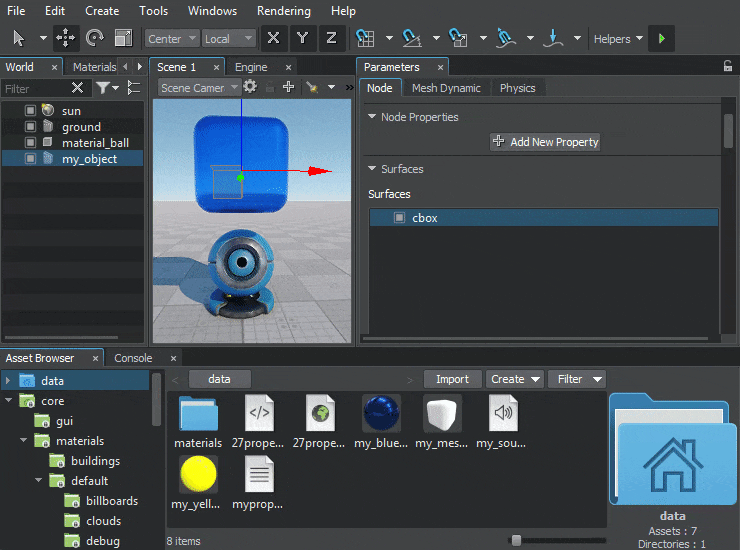Properties
For the object to be correctly integrated into the world, defining its position, inherent characteristics and outside appearance will be insufficient. Properties specify the way the object will behave and interact with other objects and the scene environment.
What is a Property?#
A property can be thought of as a "material" for application logic. It represents a set of logic-related parameters. You can define conditions, based on which parameters of the property become available/unavailable in the UnigineEditor.
Property parameters can be of various types - from a simple integer representing your character's hit points, to node, material, file (for textures, meshes, sounds, etc.), or property, which simplifies access to various resources.

You can also use complex data types in your properties which provides additional flexibility to implement your application logic. These data types are as follows:
-
Structure can be thought of as "a definition of a property inside a property". Thus, a structure is also composed of parameters of any type supported by the property, including arrays.
Structures, just like properties, can also include other structures (nested) and can be organized in hierarchy with parameter inheritance and overloading (much like in object-oriented programming). When a structure is inherited, all its parameters are inherited from the parent. If a parameter value is changed for the parent, it will be automatically changed for the child as well, unless it was overridden (set to a different value) for the child before that.
NoticeIn case if a property has a structure parameter (struct), the definition of this structure inside the *.prop file must appear before the parameter. The same is true, when a structure inherits from another structure: the parent must be defined before its child. -
Array is a collection of parameters, all having the same type, and accessed using a common name followed by an index: array[0].
Arrays can have multiple dimensions (arrays of arrays), but be careful: the amount of memory needed for an array increases exponentially with each dimension. Arrays of structures are also supported.
You can edit arrays in UnigineEditor using the context menu.
UNIGINE's Properties system includes the following:
- Manual properties implemented by programmers (including base ones).
- User properties inherited from the manual ones and adjusted via the UnigineEditor by 3D artists.
All properties in the project are organized in a hierarchy.
Each property is stored in a separate *.prop file, except for the internal properties.
Manual Properties#
Manual properties are created and edited manually: they are displayed as read-only in the UnigineEditor. It is possible to modify them via API at run time (if the corresponding flag is set), but such changes won't be saved. To customize a manual property, you should either inherit a new user property from it or directly edit the corresponding *.prop file.
In the *.prop file of a manual property its name is stored. If a manual property is inherited from another manual property, the child's *.prop file will store a name-based reference to the parent. The GUID for the manual property is uniquely determined by its name and is generated at run time.
Base Properties#
Base property is a manual property that does not have a parent, base properties are at the top-level of the hierarchy, all other properties are inherited from them.
By default, UNIGINE provides 2 built-in read-only base properties: node_base and surface_base. You can also make custom base properties of your own.
User Properties#
User property is a property inherited from any other property via the UnigineEditor, it overrides the parameters of its parent.
The *.prop file of the user property contains its GUID and a GUID-based reference to the parent property. Such file is created automatically when inheriting a new property in the UnigineEditor. The set of user property parameters is determined by its parent, while their values can be modified.
Internal Properties#
Internal property is a property without a name. When cloning or inheriting a property, each new property becomes internal until a name is assigned to it. Internal properties are also created when you assign a property to a node.
See Also#
- Hierarchy and Inheritance article to learn more about how properties are organized.
- Property GUIDs chapter to learn how to refer to manual and user properties.
- Property File Format article to learn more about the *.prop files.
- Properties class article to learn more about managing properties via API.
- Property class article to learn more about managing a property via API.
- PropertyParameter class article to learn more about managing property parameters via API.